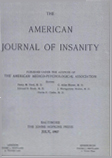Abstract
Statistics are presented dealing with the results of the Wassermann test on the blood serum of 1600 cases admitted to Danvers State Hospital. Only cases are reported in which the test has been used as a part of the routine examination.
Of 864 male cases tested, 164, or 19 per cent, were positive. Of 736 female cases, 92, or 12.5 per cent, gave positive tests. Of the 1600 cases tested, 256, or 16 per cent, were positive. Doubtful tests occurred in 3.87 per cent of the cases.
Including cases with positive spinal fluid test and negative or doubtful blood test, 273, or 17 per cent of 1600 admissions, give a positive test at some point.
Of 164 positive blood tests among males, 113, or 68.8 per cent, occurred in cases of nervous syphilis. Of 92 females with positive blood test, 32, or 34.8 per cent, were paretics. Of 256 cases with positive blood test, 145, or 56.7 per cent, are cases of nervous syphilis. Excluding paretics from all figures, positive tests occurred in 7.6 per cent of 1455 admissions.
Of the non-paretic cases with positive blood, 20 are "organic,"80 are"functional" and 10 are "unclassed."
It appears that, if an insane man has a positive blood test, the chances are better than even that he will be a paretic; while if a positive test appears in an insane female, the chances are that she will not be a paretic. When paresis is excluded, the chances are about three in four that the person with positive blood will have a "functional" psychosis.
An unexplained finding is the high percentage of positive blood tests among morphin habitues (small number of cases). No other non-paretic group contains any considerable group of cases with positive Wassermann. A person suffering from any psychosis may be syphilitic without belonging to the nerve syphilis group.
Doubtful Wassermann tests later show positive reactions in blood or spinal fluid in about one-quarter of the cases. The test should always be repeated.
Among the paretics of this series, the blood test was positive in 87.5 per cent and negative in 10.3 per cent. The spinal fluid test was positive in 87.2 per cent and negative in 8.5 per cent, while the test was positive in both fluids in 75 per cent of the cases.
Of 276 cases with test on the spinal fluid, there are 126 positive results. Of these, 109 had blood and fluid test both positive; five had doubtful blood and positive fluid test; 12 had negative blood and positive fluid test.
Of the 126 cases with positive fluid test, 121 were paretics; two imbeciles: one was organic dementia; one a heroin case; one psychoneurotic. The latter five may in the course of time develop paresis.
The statistics here presented give evidence of the great practical importance of the Wassermann test in practical psychiatry.

